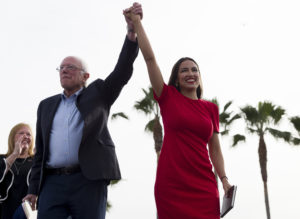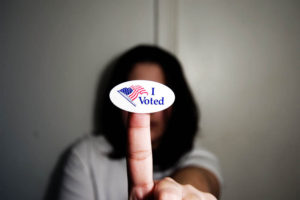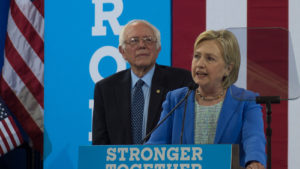Beware the Moderate Democrat
Donald Trump might look weak now, but a business-friendly opposition with no true voter base could ensure his reelection in 2020. Sen. Kirsten Gillibrand, D-N.Y., is among several moderate Democrats who have joined or are expected to join the 2020 presidential race. (Phil Roeder / Flickr )
Sen. Kirsten Gillibrand, D-N.Y., is among several moderate Democrats who have joined or are expected to join the 2020 presidential race. (Phil Roeder / Flickr )
The “moderate.”
Such a soothing political word. It conjures up a reasonable, considerate person who seeks the middle ground between ideological extremists: Works well with others, crosses the aisle to make good policy, knows how to win incremental change rather than issuing jarring proclamations that jump too far ahead of the electorate. A moderate is pragmatic, gets things done and doesn’t let the perfect become the enemy of the good.
Oh, in these troubled times, aren’t such moderates—beloved as they are by right-wingers like Bret Stephens—desperately needed?
Get ready to hear more and more of that from mainstream media pundits as the Democratic Party moves more towards the kind of progressive populism put forward by the Sanders/AOC wing of the party. We’ll be asked by centrist journalists to take a careful look at more reasonable moderates like Gillibrand, McAuliffe, Bloomberg, Biden, Booker, Landrieu and many more (e.g. “Is There Room in 2020 for a Centrist Democrat?” and “The Loneliness of a Moderate Democrat”).
But what is the substance of all this centrism and moderation?
First and foremost, these moderates are united by their unwillingness to take on Wall Street. And because of that unwillingness, they are unable to confront the defining problem of our era—runaway inequality. They cannot face up to the fact that the wages of the average worker have been stagnant for an entire generation. Meanwhile the pay gap between the top 100 CEOs and the average worker has risen from 40 to 1 in 1980 to an obscene 800 to 1 today.
The centrists run away from this problem in large part because they are in a desperate race to win the very first primary—the fundraising primary. And it is no secret that victory goes to the candidate who garners the most financial support from Wall Street/corporate Democrats.
Rather than discussing runaway inequality and ways to ameliorate it through Medicare for All, free higher education, and higher taxes on the super-rich, these moderates instead will stress enhancing “opportunity,” and “removing barriers” to race/gender advancement. Rather than confronting billionaire oligarchs they want to “partner with business” and, in some vague way tame their excesses while also building a robust and fair economy with “opportunity for all.” No conflict needed. No diatribes against the billionaire class. Hear the melodious tones of moderation.
From this coziness with Wall Street flows the trope about being “socially liberal” and “fiscally conservative.” The moderate centrists, and their Wall Street donors, support LBTQ rights, the advancement of women in business, immigration and criminal justice reform, gun control, and abortion rights. At the same time, they believe the entire progressive runaway inequality platform is an affront to economic reason: High taxes on the rich will discourage initiative and innovation; single-payer health care and free higher education will bankrupt the country; breaking up the big banks will cripple investment and jobs.
Of course, the moderates must ignore the reams of data from all over the world that show that these progressive reforms would reduce inequality and enhance the well-being of nearly everyone, though it is true that reducing inequality would harm—at least to some extent—the precious privileges of the very few. The super-rich would have to pay more. They would no longer be able to financially strip mine the rest of us through wasteful stock buy-backs. Their billions would be reduced a bit. But most alarming would be their deflated egos: No longer could they bask in the false narrative that what is so very good for them is good for all of us.
But do “moderates” represent anyone other than their Wall Street donors? Is there a mass base for the kind of moderation they are putting forward?
Let’s take a look at the eye-popping data from the 2016 presidential election, put together by the Voter Survey Group, which polled 8,000 Americans (a very large sample which is eight to fifteen times larger than most of the surveys we usually see in the news.) A study of these voters showed that they could be divided into four major groups. (See Lee Drutman, “Political Divisions in 2016 and Beyond.” Note: the title names used below are mine not his.).
- The first group, Left Populists, are those who are both social and economic progressives. They support immigration, women and minority equality, LBGTQ rights and immigration. They also worry about rising inequality and support proposals that would attack it.
- The second group, Nativist Populists, also worry about rising inequality and support proposals that attack it. But they are more comfortable with traditional gender roles, have qualms about abortion, see immigration as a problem and are not particularly supportive about LBGTQ rights.
- The third group are the Arch Conservatives who are not interested in reversing economic inequality or social inequality.
- And finally we have the Socially Liberal/Fiscal Conservatives. This is the home base for the “moderate” politicians who are wooing Wall Street and see themselves as the sensible alternatives to the extremist populists.
So more or less, that’s who we are. If the electorate were equally divided among these four groups, the “moderates” might have an argument. The facts tell a different story:
- Left Populists account for 44.6 percent of the electorate according to this study.
- 28.9 percent are Nativist Populists. This means that nearly three-quarters of all voters fear runaway inequality and want to reduce it. But these economic populists are divided on identity issues.
- Arch Conservatives account for another 22.7 percent.
- And that leaves a minuscule 3.8 percent for the Socially Liberal/Fiscal conservatives.
How pathetic is that? It goes to show how out of touch these billionaires and their accolades are from political reality. They have no base. Nada. There’s no one there… except very rich Wall Street/Corporate funders and centrist pundits who feel compelled to find a judicious balance between left and right.
Danger Ahead
The data shows why Trump’s nativist, race-baiting, immigrant-bashing base-building makes some electoral sense. If he can hold both the Nativist Populists and the Arch Conservatives he can win again. And he can do that most easily against a candidate with virtually no natural base—the “moderate”—the Socially Liberal/Fiscally Conservative Democrat.
Given enough financial support, a “moderate” might be able to buy her or his way through the Democratic primaries, especially if many candidates split the progressive populist vote. One could imagine one of the “moderates” becoming a media darling of the center, which might further enhance his or her status.
But should one of them squeak through to become the nominee, we might have a Democratic debacle. The nativist economic populists on the right might flock back to Trump along with the arch conservatives who will never leave him. Trump may look incredibly weak now, but a Wall Street-backed Democratic “moderate” with a natural base of 3.8 percent could give the worst president in American history a real chance.
Jim Hightower, the great Texan populist, turned a phrase that comes to mind every time a Wall Street “moderate” is touted.
“There’s nothing in the middle of the road,” he famously quipped, “but yellow stripes and dead Armadillos.”
Your support matters…Independent journalism is under threat and overshadowed by heavily funded mainstream media.
You can help level the playing field. Become a member.
Your tax-deductible contribution keeps us digging beneath the headlines to give you thought-provoking, investigative reporting and analysis that unearths what's really happening- without compromise.
Give today to support our courageous, independent journalists.






You need to be a supporter to comment.
There are currently no responses to this article.
Be the first to respond.